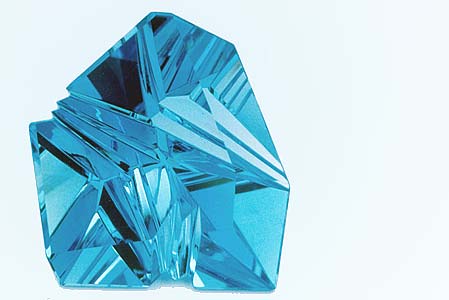 |  |
From the light blue of the sky to the deep blue of the sea, aquamarines shine over an extraordinarily beautiful range of mainly light blue colours. Aquamarine is a fascinatingly beautiful gemstone. Women the world over love it for its fine blue shades which can complement almost any skin or eye colour, and creative gemstone designers are inspired by it as they are by hardly any other gem, which enables them to create new artistic cuts again and again.
Its light blue arouses feelings of sympathy, trust, harmony and friendship. Good feelings. Feelings which are based on mutuality and which prove their worth in lasting relationships. The blue of aquamarine is a divine, eternal colour, because it is the colour of the sky. However, aquamarine blue is also the colour of water with its life-giving force. And aquamarine really does seem to have captured the lucid blue of the oceans. No wonder, when you consider that according to the saga it originated in the treasure chest of fabulous mermaids, and has, since ancient times, been regarded as the sailors' lucky stone. Its name is derived from the Latin 'aqua' (water) and 'mare' (sea). It is said that its strengths are developed to their best advantage when it is placed in water which is bathed in sunlight. However, it is surely better still to wear aquamarine, since according to the old traditions this promises a happy marriage and is said to bring the woman who wears it joy and wealth into the bargain. An ideal gem, not only for loving and married couples.
A gemstone with many good qualities
Aquamarine is one of our most popular and best-known gemstones, and distinguishes itself by many good qualities. It is almost as popular as the classics: ruby, sapphire and emerald. In fact it is related to the emerald, both belonging to the beryl family. The colour of aquamarine, however, is usually more even than that of the emerald. Much more often than its famous green cousin, aquamarine is almost entirely free of inclusions. Aquamarine has good hardness (7.5 to 8 on the Mohs scale) and a wonderful shine. That hardness makes it very tough and protects it to a large extent from scratches. Iron is the substance which gives aquamarine its colour, a colour which ranges from an almost indiscernible pale blue to a strong sea-blue. The more intense the colour of an aquamarine, the more value is put on it. Some aquamarines have a light, greenish shimmer; that too is a typical feature. However, it is a pure, clear blue that continues to epitomise the aquamarine, because it brings out so well the immaculate transparency and magnificent shine of this gemstone.
The bright blue of this noble beryl is making more and more friends. The various colour nuances of aquamarine have melodious names: the rare, intense blue aquamarines from the Santa Maria de Itabira mine in Brazil, which make every gemstone lover's heart beat faster, are called 'Santa Maria'. Similar nuances come from a few gemstone mines in Africa, particularly Mozambique. To help distinguish them from the Brazilian ones, these aquamarines have been given the name 'Santa Maria Africana'. The 'Espirito Santo' colour of aquamarines from the Brazilian state of that name is of a blue that is not quite so intense. Yet other qualities are embodied in the stones from Fortaleza and Marambaia. One beautiful aquamarine colour was named after the Brazilian beauty queen of 1954, and has the name 'Martha Rocha'.
It can be seen from the names of aquamarine colours just how important Brazil is among the countries where aquamarine is found. Most of the raw crystals for the world market come from the gemstone mines of that large South American country. Every now and then, large aquamarine crystals of immaculate transparency are also found with a magnificent colour, a combination which is very unusual in gemstones. And very occasionally, sensationally large aquamarine crystals come to light in Brazil, such as the crystal of 110.5 Kg found in 1910 in Marambaia/Minas Gerais, or for example the 'Dom Pedro', weighing 26 Kg and cut in Idar-Oberstein in 1992 by the gemstone designer Bernd Munsteiner, the largest aquamarine ever to have been cut. However, aquamarines are also found in other countries, for example Nigeria, Zambia, Madagascar, Mozambique, Afghanistan and Pakistan.
There is hardly any other gemstone in modern jewellery design which is refined in such a variety of ways as aquamarine. Whether it is fashioned as a clear, transparent gem in the classical step cut, or creatively cut in a more modern design, it is always fascinatingly beautiful. Uncut too, or with many inclusions which can be brought into play by the designer in the way in which the stone is cut, it can be refined to produce the most beautiful creations. Designers call it their favourite gemstone. Again and again they take the world by surprise with a new, modern artistic cut, and when they are breaking new ground, aquamarine is a gem that they particularly like to work with. Without doubt, these creative designer cuts have contributed to the great popularity of this gem. The lucid colour of aquamarine makes it easy to see inclusions. For this reason, aquamarine should always be of the greatest possible transparency. On the other hand, particularly charming effects can sometimes be achieved in the way the gemstone is cut by bringing the inclusions into play. The light colour of aquamarine leaves the gemstone designer free to bring out the brilliance of the gem with fine grooves, notches, curves and edges. In this way, each aquamarine becomes a unique specimen, whose magical attraction no woman can resist.